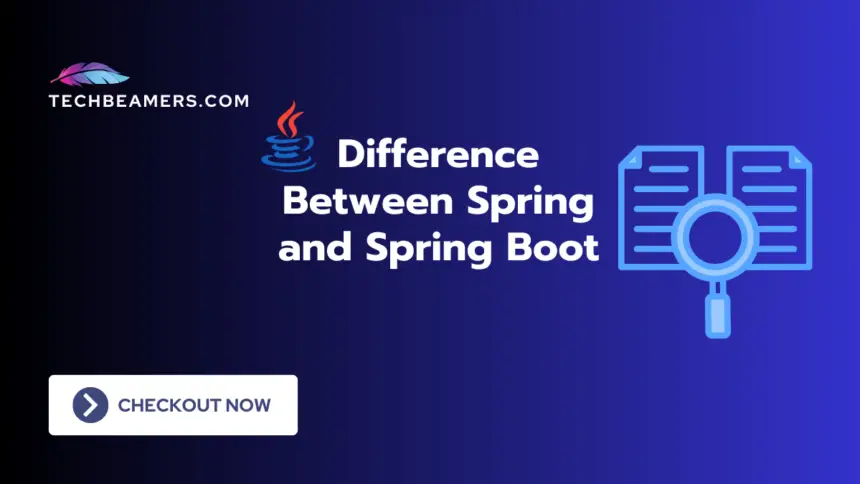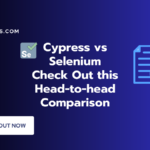In this short tutorial, we’ll explain the key differences between Spring and Spring Boot. These are two correlated terms and technologies in the Java programming world. They help developers create applications, but they have different focuses.
The Difference Between Spring and Spring Boot
Both these technologies have significantly contributed to the increasing footprint of cloud services throughout the internet. They have become an important skill for web app development and Java developers. Let’s find out more about these two in a bit more depth.
Also Read: Top 20 Spring Boot Interview Questions and Answers
Let’s Compare Based on Several Project Parameters
When we start a web application project, we have to consider many things. The first thing that may come to your mind is the technology to choose for the development. If we have to pick between two technologies such as Spring and SpringBoot, then the following comparison could help.
1. Purpose
- Spring:
- Spring is a big framework for building complex Java applications. It has many features for things like handling data, managing transactions, ensuring security, creating web applications, and more.
- Spring Boot:
- It is made to simplify the process of building and running Spring applications. It’s like a shortcut that sets up a lot of things for you. It’s great for getting started quickly.
2. Configuration
- Spring:
- In Spring, you need to tell it how things should work. You do this by writing code or using special files. It gives you a lot of control, which is good for big and complicated projects.
- Spring Boot:
- It tries to do a lot for you automatically. It follows some rules, and if you follow those rules, you don’t have to write as much code. It’s like having a default setup that you can change if you need to.
3. Project Structure
- Spring:
- In Spring, you decide the layout of your project folders and files. There’s no strict rule; you do what makes sense for your project.
- Spring Boot:
- It has a specific way in which you should arrange your project files. It’s like having a recipe – you know where to put your ingredients. This helps everyone understand where things are.
4. Embedded Server
- Spring:
- In Spring, you need to pick a server to run your application, like Tomcat or Jetty. You set it up separately.
- Spring Boot:
- Spring Boot comes with a server already inside it. It’s like having a cake that bakes itself. You don’t need to worry about setting up a separate server.
5. Dependency Management
- Spring:
- In Spring, you decide which tools you want to use and make sure they work together. You might need to check which versions go well together.
- Spring Boot:
- It helps by picking tools that work well together. It’s like having a set menu – you just choose what you want. It makes sure everything works smoothly.
6. Ease of Development
- Spring:
- Spring is powerful but can be a bit complicated. You need to do more yourself, but you have more control.
- Spring Boot:
- It is like the easy mode. It’s made to be quick and simple. You don’t have to write as much code, making it more friendly for developers.
Filter Out the Differences Between Spring and Spring Boot
We are not done yet. Here’s a further breakdown of the key differences.
Spring
- Concept: A lightweight framework for building enterprise Java applications.
- Focus: Provides core functionalities like Dependency Injection, Aspect-Oriented Programming, and Data Access.
- Configuration: Requires XML or annotated configuration for setup, which can be verbose and time-consuming.
- Ideal for: Building complex, large-scale enterprise applications where flexibility and customization are paramount.
Spring Boot
- Concept: A simplified extension of Spring for easier web application development.
- Focus: Enables rapid development of standalone, production-ready Spring applications.
- Configuration: Uses sensible defaults and auto-configuration to minimize manual configuration.
- Ideal for: Building microservices, REST APIs, and small to medium-sized applications where speed and simplicity are prioritized.
Head-to-head Comparison
Here’s a table summarizing the key differences:
| Feature | Spring | Spring Boot |
|---|---|---|
| Type | It is a Web Development Framework. | It is a Spring Framework Extension. |
| Focus | On Core Functionalities | Supports Rapid Application Development |
| Configuration | Supports XML or Annotated | Requires Minimal Manual Configuration |
| Complexity | More Flexible and Customizable | Simpler and Faster to Set up |
| Ideal for | Complex Enterprise Applications | Microservices, REST APIs, Small-Medium Applications |
In simpler terms:
- Spring is like a toolbox with all the components you need to build a house. You have to choose and assemble everything yourself.
- Spring Boot is like a ready-house kit with most things already in place. You just need to add a few touches and it’s ready to go.
Spring or Spring Boot – Which One Should You Choose?
Choosing between the two techs depends on your project’s needs:
- Use Spring if:
- You need maximum flexibility and customization.
- You’re building a large, complex enterprise application.
- Use Spring Boot if:
- You want to develop applications quickly and easily.
- You’re building microservices, REST APIs, or small-medium applications.
We hope this explanation is clear and helpful! Let us know if you have any further questions.
In summary, Spring is like a versatile toolbox for any task, while Spring Boot is like a ready-to-use toolbox for common tasks. Your choice depends on how much control you need and how fast you want to start.
Happy Learning,
Team TechBeamers









